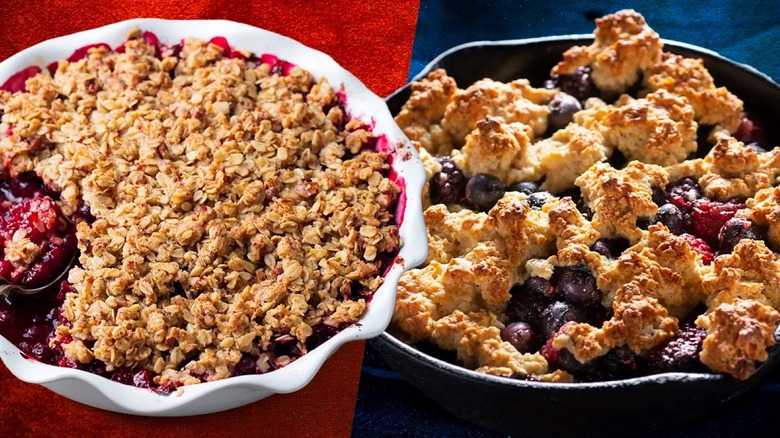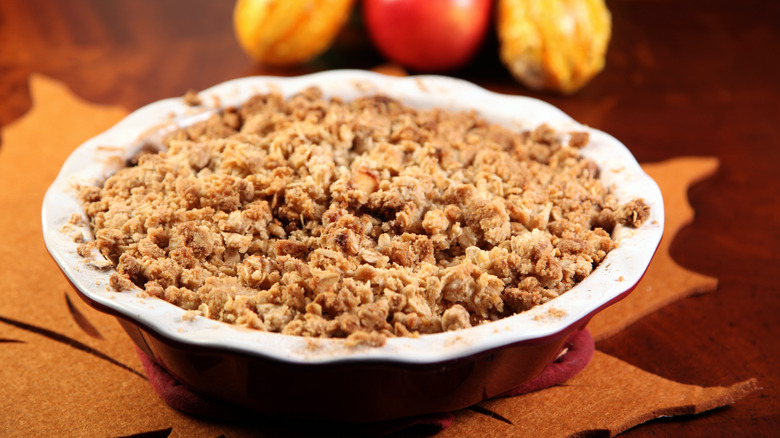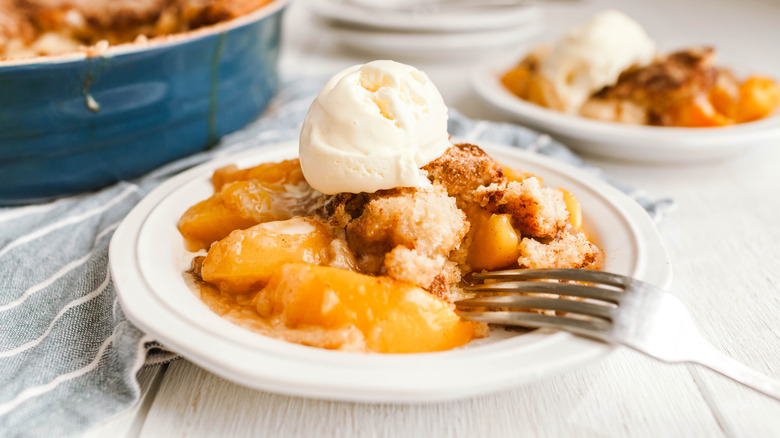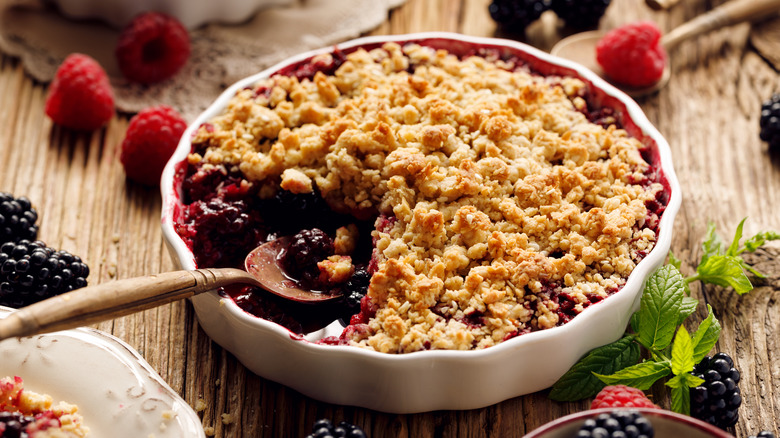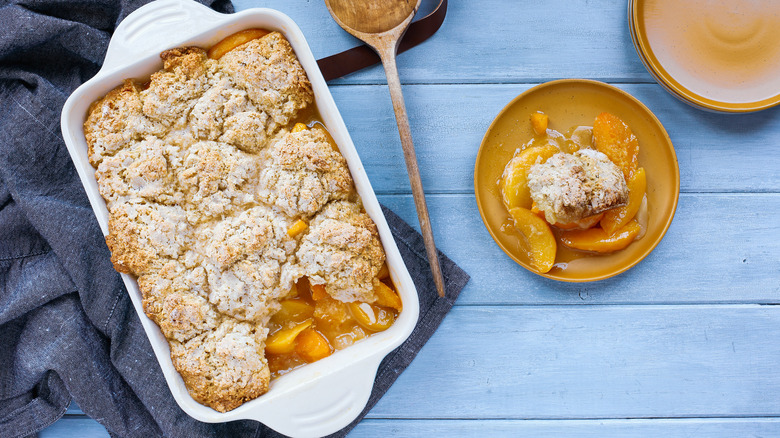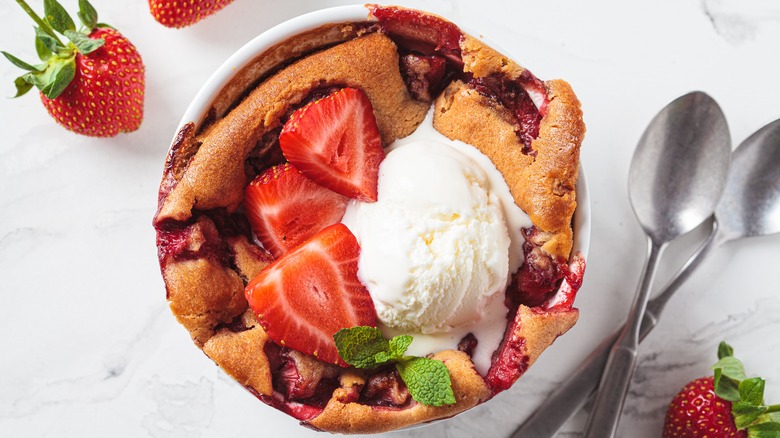What's The Difference Between A Cobbler And A Crumble?
The world of baked fruity desserts is vast but confusing. Between pies, galettes, crisps, buckles, dump cakes, cobblers, and crumbles, it can be difficult to figure out which one to make. But the latter two desserts can be especially baffling, as cobblers and crumbles are very similar. They both are made in baking dishes, include one or more fruits, and involve a golden pastry topping that also serves to soak up all those delicious juices. When you pull both out of the oven after about 45 minutes, you'll find your baked, sugary fruit fillings bubbling up underneath.
So what's the difference between these two? The biggest one lies in the desserts' toppings. Crumbles are aptly named for the crumbled-up mixture that gets sprinkled over the fruit. Cobblers, on the other hand, involve fully formed biscuits that are plopped on top of the filling — making what looks like an edible cobblestone street, which is where the name comes from. This distinction may sound small, but it affects everything from the ingredient list, to the prep steps, to the difficulty level in making each dessert. Plus, while the flavors in these two treats are very similar, you'll notice slight distinctions in texture when biting into each.
Necessity was the mother of this crumbly invention
As we know, crumbles are baked fruit desserts with a sweet topping sprinkled on top. If they sound similar to pies, that's because they are — and in fact, the treat was originally developed as a twist on apple pie. The invention came out of necessity, as ingredients to make a full apple pie were scarce during World War II, so British cooks turned to a simpler topping instead. The first recorded crumble recipe in the U.S. debuted in 1924, where it may have been inspired by yet another baked fruit dish, the slump. But while the former keeps the fruit cozy underneath the crumbly topping, the latter elevates it to the top of the pile.
Although this treat has British and American roots, it's since traveled across borders to be enjoyed by other countries. French chefs have embraced the dessert despite its simplicity, while German cooks often put their own spin on it by including raisins and rum. The beauty of the crumble is that it can be made myriad ways using a plethora of different fruits, as long as the basic elements stay the same: the sweet fruity layer and the streusel-like topping.
Cobblers were a colonial creation
Cobblers may have walked so that crumbles could run, as the former first popped up in the 1800s. But their origin stories have plenty in common — both of these desserts began as less fancy versions of pie from those who didn't have as much access to highly sought-after ingredients as the wealthy. But while crumbles became popular during World War II in Britain, cobblers were invented by colonial settlers in the early days of the U.S. These folks aimed to imitate the dishes they previously made in their homeland of Europe but with ingredients that they could get their hands on in their new country.
While we typically make cobblers in the oven today, settlers back in the day often cooked theirs over a fire in a cast-iron pan. They loved them so much that they would eat them for breakfast, lunch, or dinner, and it took until the end of the 19th century until they morphed into dessert territory — so if you've ever had the urge to down your cobbler in the middle of the day, you're simply following in the footsteps of early American colonists. As the dessert became more well known, it traveled across the U.S., where different regions put their own spin on it. Peaches became a popular fruit of choice in the South, for instance, while huckleberries were beloved in the Northwest.
Crumbles use a streusel-like topping
The biggest difference between a cobbler and a crumble? The topping. Crumbles typically deploy a topping very similar to streusel, and you can generally sprinkle the same ingredients on a bakery muffin as you can with one of these sweet treats. To make the garnish for a crumble, you'll typically need flour, sugar, and butter. In this sense, it's simpler to make this treat than to whip up a crisp, which typically also includes oats. You can use white, brown, or coconut sugar, or a combination of two or more of these.
Creating the pastry part of this dessert involves combining those three ingredients (perhaps with a little cinnamon as well) in a food processor. As an alternative, you can use your hands or a pastry cutter. The result you're looking for is an even mixture with a crumbly consistency, worthy of the name of the dessert. Once it's good to go, you'll sprinkle your streusel on top of your fruit in a baking dish. It won't be enough to cover your filling completely, like a pie crust might, but you should get golden, delicious pastry in every bite.
Cobblers use biscuits to soak up fruity juices
Unlike the scattered streusel of a crumble, a cobbler's topping looks much more put-together. The dish is essentially the dessert version of chicken and dumplings, as a fruity mixture bakes underneath globs of biscuit dough plopped on top. Making the dough is a little more complex than a crumble's pastry, as you'll typically need flour, sugar, butter, baking powder, milk (or buttermilk), and salt — although some cobblers also deploy raw sugar for the final topping. With both desserts, however, you'll want the butter cold and cubed before you get started.
The process for making the biscuits is also a little more complex than combining the ingredients for a streusel topping. You'll want to start off in a similar way, by mixing everything together until you get a crumbly texture. But once your filling is spread out in your baking dish, you can then drop spoonfuls over the top, spacing them out so they can expand in the oven. If you want more uniform biscuits, you can also roll the dough out beforehand and separate out circles with a cookie cutter. As a last step, cobblers are typically brushed with an egg wash so the topping comes out nice and golden. When you go to take a bite, you'll get warm, sweet fruit and soft, pillowy biscuits with crispy edges.
Modern-day cobbler variations switch up the batter
While the classic version of a cobbler is the one we've outlined above, the term has become looser over the years. A dessert with carefully placed biscuits that resemble cobblestones is one version of this treat, but these days, you may also see varieties in which the batter is simply poured over the top of the filling. In this case, the butter is usually melted and mixed with similar ingredients like flour, milk, salt, and baking powder. This is arguably easier than whipping up biscuits because you don't need to worry about keeping the butter cold, and you can simply pour the batter on top of the fruit. Once your cobbler is out of the oven, the crust's texture may remind you more of cake than biscuits.
A particularly delicious variation of this dessert involves a cookie dough topping. This still counts as a cobbler because all the other elements of the dish are there — but the ingredient list expands to include eggs and vanilla extract, and possibly tasty additions like lavender or chocolate chips. You'll essentially make the batter for drop cookies, which are then plopped on top of your filling just like the biscuits would be. Is this variety authentic to what the first settlers of America made over an open fire? Not really. But it is delectable and just as easy? Absolutely.
